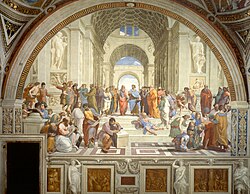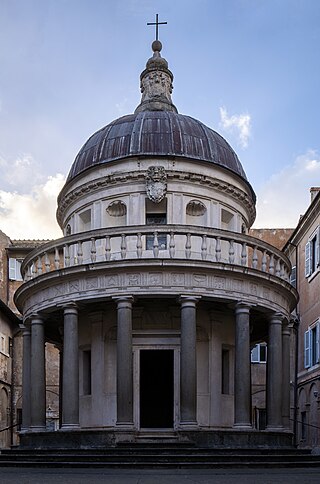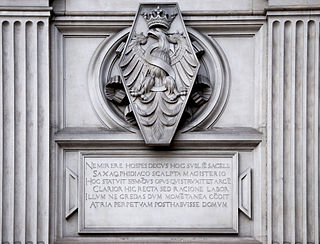| Renaissance |
|---|
 |
| Aspects |
| Regions |
| History and study |
The Lublin Renaissance was an architectural style developed in the Lublin region of Poland at the end of the 16th century. [1]
| Renaissance |
|---|
 |
| Aspects |
| Regions |
| History and study |
The Lublin Renaissance was an architectural style developed in the Lublin region of Poland at the end of the 16th century. [1]
The Lublin region has a fine architectural heritage. It was at the end of the 16th century that the first fully developed forms of Renaissance architecture were imported into the Lublin region. The beginning of the next century saw an enormous increase in the number of fine religious buildings developed as a result of the great wealth created by the Lublin region being one of the most important exporters of grain to Western Europe. The majority of churches were erected by architects of Italian origin who in this way created a local style known as the Lublin Renaissance. Churches built in this style are aisleless with a bigger presbytery than is usual, which ends in a semicircle, as well as having a barrel vault. Their distinctive features are richly ornamented gables and stucco decoration of the interior. The Lublin Renaissance is best represented by the churches in Lublin, Końskowola and Kazimierz Dolny. [2]
Visitors will also be entranced by the rich ornamentation of the Renaissance house fronts, especially the high attics of the houses in a number of the region's towns and villages. The best examples of these are the Przybyłów and Celejowska houses also in Kazimierz Dolny.

Renaissance architecture is the European architecture of the period between the early 15th and early 16th centuries in different regions, demonstrating a conscious revival and development of certain elements of ancient Greek and Roman thought and material culture. Stylistically, Renaissance architecture followed Gothic architecture and was succeeded by Baroque architecture. Developed first in Florence, with Filippo Brunelleschi as one of its innovators, the Renaissance style quickly spread to other Italian cities. The style was carried to other parts of Europe at different dates and with varying degrees of impact.

Chinon is a commune in the Indre-et-Loire department, Centre-Val de Loire, France.

Zamość is a historical city in southeastern Poland. It is situated in the southern part of Lublin Voivodeship, about 90 km (56 mi) from Lublin, 247 km (153 mi) from Warsaw. In 2021, the population of Zamość was 62,021.

The Lublin Voivodeship, also known as the Lublin Province, is a voivodeship (province) of Poland, located in southeastern part of the country. It was created on January 1, 1999, out of the former Lublin, Chełm, Zamość, Biała Podlaska and (partially) Tarnobrzeg and Siedlce Voivodeships, pursuant to Polish local government reforms adopted in 1998. The region is named after its largest city and regional capital, Lublin, and its territory is made of four historical lands: the western part of the voivodeship, with Lublin itself, belongs to Lesser Poland, the eastern part of Lublin Area belongs to Red Ruthenia, and the northeast belongs to Polesie and Podlasie. Lublin Voivodeship borders Subcarpathian Voivodeship to the south, Świętokrzyskie Voivodeship to the south-west, Masovian Voivodeship to the west and north, Podlaskie Voivodeship along a short boundary to the north, Belarus and Ukraine to the east. The region's population as of 2019 was 2,112,216. It covers an area of 25,155 square kilometres (9,712 sq mi).

Puławy is a city in eastern Poland, in Lesser Poland's Lublin Voivodeship, at the confluence of the Vistula and Kurówka Rivers. Puławy is the capital of Puławy County. The city's 2019 population was estimated at 47,417. Its coat of arms is based on Pogonia.

Opole Lubelskie is a town in southeastern Poland. As of 2004, it had 8,879 inhabitants. The town is situated in Lublin Voivodeship, some 10 kilometers east of the Vistula River, and is the capital of Opole Lubelskie County. It was founded in the 14th century, and historically belongs to Lublin Land, which is part of Lesser Poland.

Kazimierz Dolny is a small historic town in eastern Poland, on the right (eastern) bank of the Vistula river in Puławy County, Lublin Voivodeship. Historically it belongs to Lesser Poland, and in the past it was one of the most important cities of the province.

The culture of Poland is the product of its geography and distinct historical evolution, which is closely connected to an intricate thousand-year history. Poland has a Roman Catholic majority, and religion plays an important role in the lives of many Polish people. Polish culture forms an important part of western civilization and the western world, with significant contributions to art, music, philosophy, mathematics, science, politics and literature. Its unique character developed as a result of its geography at the confluence of various European regions.

In classical architecture, the term attic refers to a storey above the cornice of a classical façade. The decoration of the topmost part of a building was particularly important in ancient Greek architecture and this came to be seen as typifying the Attica style, the earliest example known being that of the monument of Thrasyllus in Athens.

The Gothic architecture arrived in Poland in the first half of the 13th century with the arrival of the Dominican and Franciscan orders. The first elements of the new style are evident in the foundation of the Dominican Trinity church in Kraków (1226–1250), built by Bishop Iwo Odrowąż. Rebuilding of the Wrocław Cathedral, started in 1244, was another early manifestation of the Gothic style. The earliest building in Poland built entirely in the Gothic style is the chapel of St. Hedwig in Trzebnica (1268–1269), on the grounds of a Cistercian monastery.

Końskowolapronounced[kɔɲskɔˈvɔla] is a village in southeastern Poland, located between Puławy and Lublin, near Kurów on the Kurówka River. It is the seat of a separate commune (gmina) within Puławy County in Lublin Voivodeship, called Gmina Końskowola; population: 2,188 inhabitants.

The Renaissance in Poland lasted from the late 15th to the late 16th century and is widely considered to have been the Golden Age of Polish culture. Ruled by the Jagiellonian dynasty, the Crown of the Kingdom of Poland actively participated in the broad European Renaissance. The multinational Polish state experienced a period of cultural growth thanks in part to a century without major wars, aside from conflicts in the sparsely-populated eastern and southern borderlands. The Reformation spread peacefully throughout the country, and living conditions improved, cities grew, and exports of agricultural products enriched the population, especially the nobility (szlachta), who gained dominance in the new political system of Golden Liberty.
Renaissance architecture was that style of architecture which evolved firstly in Florence and then Rome and other parts of Italy as the result of Renaissance humanism and a revived interest in Classical architecture. It was part of the general movement known as the Italian Renaissance, which spread outwards from Italy and effected many aspects of scholarship and the arts. When the Renaissance spirit was exported into Eastern Europe, it had to compromise with local traditions and climates. The Renaissance style differs from place to place throughout the region with many local characteristics making themselves apparent.

Bochotnica is a village in the administrative district of Gmina Kazimierz Dolny, within Puławy County, Lublin Voivodeship, in eastern Poland. It lies in historic province of Lesser Poland, approximately 3 kilometres (2 mi) north-east of Kazimierz Dolny, 10 km (6 mi) south of Puławy, and 42 km (26 mi) west of the regional capital Lublin. The village is located on the right bank of the Vistula, on the road between Puławy and Kazimierz Dolny. The ruins of a 14th-century castle are located nearby.

Wąwolnica is a village in Puławy County, Lublin Voivodeship, in eastern Poland. It is the seat of the gmina called Gmina Wąwolnica. It lies approximately 19 kilometres (12 mi) south-east of Puławy and 31 km (19 mi) west of the regional capital Lublin.

The architecture of Poland includes modern and historical monuments of architectural and historical importance.

Mannerist architecture and sculpture in Poland dominated between 1550 and 1650, when it was finally replaced with baroque. The style includes various mannerist traditions, which are closely related with ethnic and religious diversity of the country, as well as with its economic and political situation at that time. The mannerist complex of Kalwaria Zebrzydowska and mannerist City of Zamość are UNESCO World Heritage Sites.
The architecture of Switzerland was influenced by its location astride major trade routes, along with diverse architectural traditions of the four national languages. Romans and later Italians brought their monumental and vernacular architecture north over the Alps, meeting the Germanic and German styles coming south and French influences coming east. Additionally, Swiss mercenary service brought architectural elements from other lands back to Switzerland. All the major styles including ancient Roman, Romanesque, Gothic, Renaissance, Baroque, Neoclassical, Art Nouveau, Modern architecture and Post Modern are well represented throughout the country. The founding of the Congrès International d'Architecture Moderne in La Sarraz and the work of Swiss-born modern architects such as Le Corbusier helped spread Modern architecture throughout the world.

Saints Catherine and Florian Church in Gołąb, Poland, is an early seventeenth-century church.